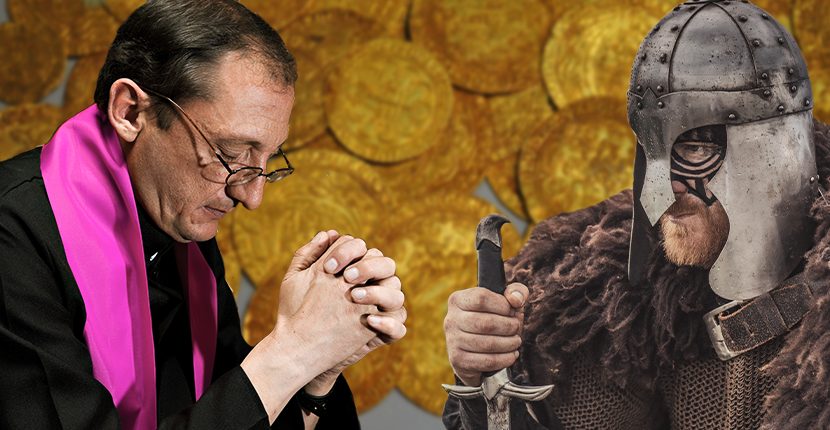In 2014, a hoard of Viking treasure was discovered in a churchyard in Galloway, Scotland. It had lain in the ground for over one thousand years until unearthed by Derek McLennan, from Ayrshire, with his metal detector. At the time McLennan promised to share the proceeds from the sale of the items, about two million pounds, with the church but has since reportedly gone back on his word.
The Reverend David Bartholomew, a friend who is a pastor of the church, the church elders, and the trustees of the Church of Scotland have not been able to reach McLennan causing them to finally file suit against the detectorist. Reverend Bartholomew was with McLennan when the treasure was found and has expressed surprise that his friend would disregard his given word. According to the Daily Mail, the Reverend commented, “Derek was my friend and it is sad that it has come to this.”
The National Museum of Scotland reports that the Galloway Hoard, as it is now called, consists of over one hundred items including mostly gold and silver jewelry, an engraved Carolingian silver vessel complete with a lid, Byzantine silk, an enameled cross, Anglo Saxon disc brooches with designs never before seen in Scotland, silver bookmarks, a unique gold bird pin, beads, gold ingots, and even leather and wooden objects. Most of the objects are types of Viking Age items that have never been found in Scotland.
A first glimpse of the Galloway hoard pic.twitter.com/4vW7paklMI
— BBC South Scotland (@BBCSouthScot) June 15, 2017
The 1996 Treasure Act and the Portable Antiquities Scheme covers metal detectorist finds in England and Wales with a list of rules, including some that require the detectorist to report any finding of items over three hundred years old and at least ten percent precious metal to the landowner and the police, especially if human remains are found, within fourteen days.
The Galloway Hoard is a unique find of Viking-age gold, silver & jewelled treasures. Find out more: https://t.co/irWGlbSBkm #SavetheHoard pic.twitter.com/df80jw3zdr
— National Museums Scotland (@NtlMuseumsScot) May 16, 2017
The finder and landowner are both entitled to the full market value of the find, usually on a 50-50 basis. The value is determined by Treasure Valuation Committee administered by the British Museum. Scotland has no such half and half law and the entire value is given to the finder. Legally, McLennan may be within his rights to keep the money; ethically, some believe he was wrong to not honor his promise to the church.
McLennan and his partner, Sharon McKee have founded Beyond The Beep, a metal detecting business and it is probable that the money helped pay the medical bills when McKee was critically injured in an automobile accident in 2017 according to The Daily Record.
There has been some argument regarding the ultimate fate of the hoard which was purchased by the National Museum of Scotland. Locals want to see it in the nearby Kirkcudbright Galleries while others believe it should be housed in the National Museum of Scotland in Edinburgh.
Currently, the Viking treasure hoard is scheduled to tour museums in Scotland starting in May of 2020 with visits to the National Museum of Scotland, Kirkcudbright Galleries, Aberdeen Art Gallery, and finishing up at The McManus: Dundee’s Art Gallery and Museum in August of 2022.
After the tour is over, the majority of the Viking treasure hoard will be kept at the National Museum of Scotland, but BBC News reports that some will be on display at Kirkcudbright Galleries. The public raised over two hundred thousand pounds to help the National Museum pay for the hoard, and another one million was given by the National Heritage Memorial Fund which is financed by the UK government. The Scottish government donated one hundred fifty thousand pounds. Any money collected later or left over from the purchase price will be used for conservation.
Related Article: A Farmer’s Misplaced Hammer Led to the Largest Roman Treasure in Britain
Quoted in CNN, the secretary for culture, Fiona Hyslop MSP, remarked, “The Galloway Hoard is one of the most important collections ever discovered in Scotland. It is important that the hoard is made available for the people of Scotland and our visitors from around the world to see. “
